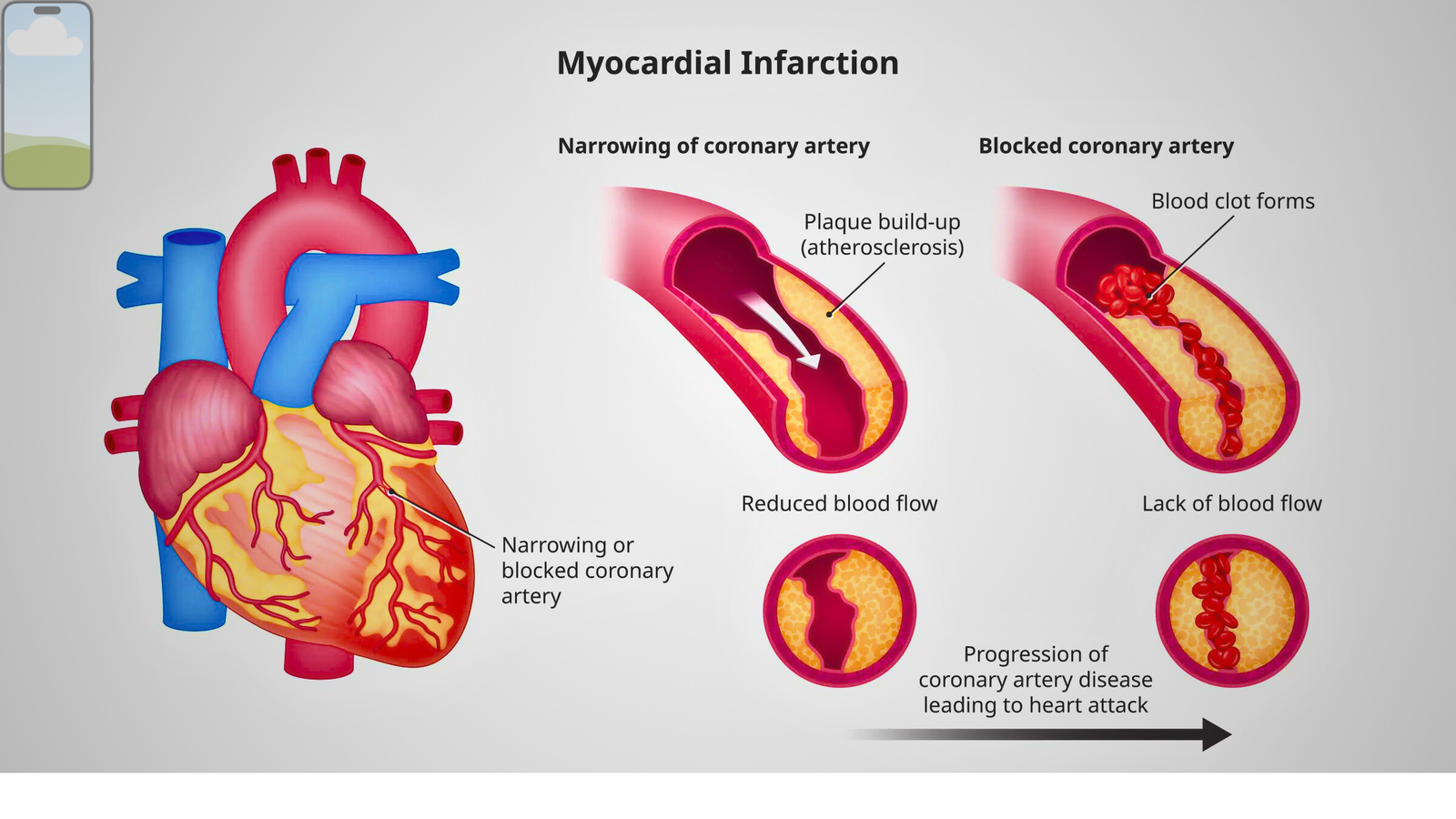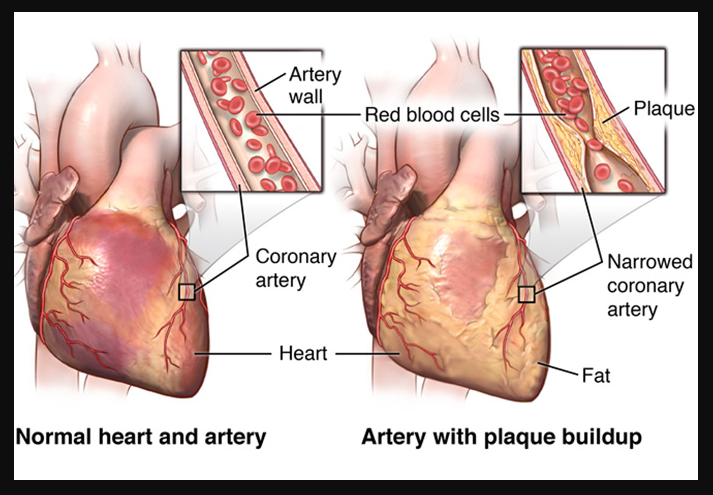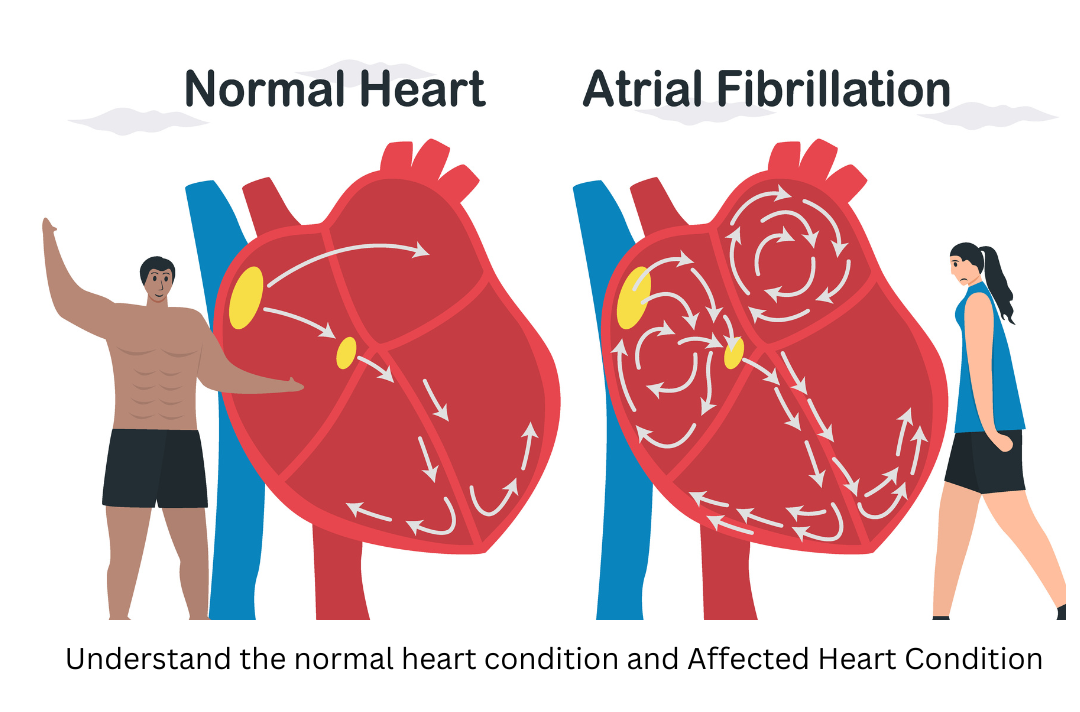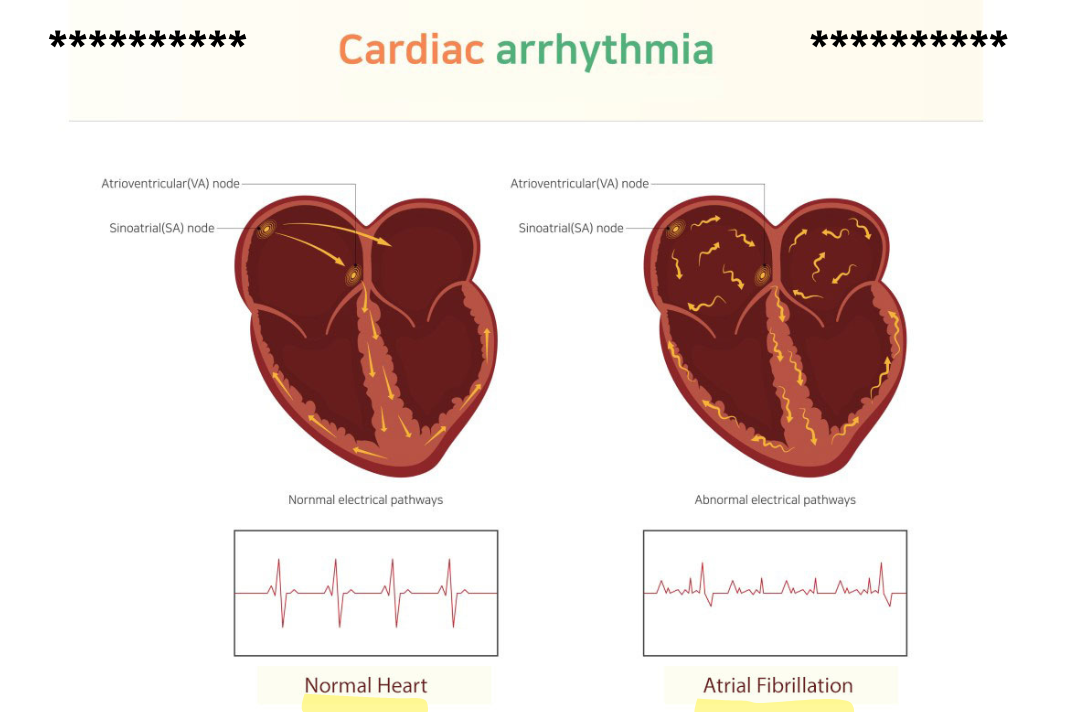Myocardial Infarction, often called a heart attack, happens when there is a blockage in the blood vessels that supply the heart muscle. Imagine these blood vessels as tiny roads, and a heart attack is like a roadblock that stops the normal flow of traffic. This blockage prevents the heart muscle from getting the oxygen and nutrients it needs, causing damage.
In a heart attack, a part of the heart may not receive enough blood, and it’s a bit like a section of a city not getting its electricity. This can lead to chest pain or discomfort, and it’s the body’s way of signaling that something isn’t quite right. When the heart doesn’t get the blood it needs, it’s like a car engine not getting enough fuel to run smoothly.
Read.. What is Aortic Stenosis? Causes, Symptoms & Treatment
Doctors can diagnose a heart attack using tests like an EKG to understand how well the heart is working. Sometimes, medical procedures like angioplasty are performed to open up the blocked blood vessels. It’s like fixing a roadblock so that traffic can flow smoothly again.
Understanding Myocardial Infarction is like learning about a traffic jam in the heart’s roads. By picturing these concepts, we can grasp how a heart attack happens and why it’s important to take care of our hearts through a healthy lifestyle. If you ever hear the term Myocardial Infarction, remember it’s like a temporary roadblock in the heart’s roads, and doctors work to clear it, ensuring our hearts stay strong and healthy.
Read.. What is Mitral Valve Prolapse? Its Causes, Symptoms & Treatment
Causes of Myocardial Infarction
Myocardial Infarction, commonly known as a heart attack, is like a puzzle, and understanding its causes helps us solve it. Let’s explore these reasons in a way that’s easy to understand, even for a sixth-grader.
- Build-up of Plaque: One of the main culprits behind Myocardial Infarction is the build-up of plaque in the blood vessels that supply the heart. Picture this plaque as sticky cheese clogging the heart’s tiny roads, making it harder for blood to flow smoothly.
- Unhealthy Eating Habits: Sometimes, what we eat plays a role in creating that sticky cheese. Consuming too many fatty and processed foods can contribute to the build-up of plaque, narrowing the heart’s roads over time.
- Lack of Exercise: Think of our heart as a muscle that needs regular workouts. When we don’t exercise enough, it’s like the heart is taking a break, making it more challenging for it to pump blood efficiently.
- Smoking and Tobacco Use: Smoking is like blowing tiny clouds of trouble into our hearts. It damages blood vessels and accelerates the build-up of plaque, creating more obstacles in the heart’s roads.
- High Blood Pressure: High blood pressure is like a constant push on the heart’s roads. It can damage the vessels over time, contributing to the formation of plaque and making it harder for blood to flow smoothly.
- Diabetes: Diabetes is like a sneaky intruder affecting how our bodies handle sugar. It can increase the chances of plaque build-up, creating more challenges for the heart’s roads.
- Genetics: Sometimes, the puzzle of Myocardial Infarction has a genetic piece. If someone in our family has had a heart attack, it can increase the likelihood of us facing the puzzle too.
- Age and Gender: Growing older is a natural part of life, but as we age, the risk of Myocardial Infarction puzzle pieces appearing increases. Men tend to face this puzzle more than women, especially at an earlier age.
Read.. What is Arrhythmias? Its Causes, Symptoms & Treatment
Symptoms of Myocardial Infarction
Myocardial Infarction, commonly known as a heart attack, can send signals that our bodies need attention. Let’s explore these signals, or symptoms, in a way that’s easy to understand for a sixth-grader.
- Chest Discomfort: One of the primary signals of Myocardial Infarction is chest discomfort. It’s like a tight feeling or pressure in the chest, as if something heavy is sitting there.
- Shortness of Breath: Feeling like you can’t catch your breath is another signal. It’s like your lungs working hard to fill up with air, but something is making it difficult.
- Fatigue: Imagine feeling tired all the time, as if your body is giving you a signal that it needs a break. This can happen during a heart attack when the heart is working extra hard.
- Sweating: Sweating more than usual, especially if there’s no clear reason, is like your body’s way of saying, “Hey, something is not right.”
- Nausea or Dizziness: Feeling sick to your stomach or dizzy can be signals too. It’s like your body’s way of telling you that it needs help.
- Pain in the Arms, Neck, Jaw, or Back: Pain in these areas can be like Morse code from your body. It could be indicating that your heart is sending distress signals.
- Irregular Heartbeat: Sometimes, your heart’s rhythm might feel off. It’s like a little drummer boy playing a different beat, signaling that your heart needs attention.
Read.. What is Heart Failure? Cause, Symptoms & Treatment
Treatment of Myocardial Infarction
When it comes to taking care of our hearts after a Myocardial Infarction, or heart attack, it involves a bit of teamwork between us and the doctors. Let’s explore the steps taken to help hearts heal in a way that’s easy for a sixth-grader to understand.
- Emergency Care: If someone is having a heart attack, emergency care is like the first line of defense. Quick action, such as calling 911, helps get the right help to the person in need.
- Medications: Doctors often prescribe medications to help the heart recover. It’s like giving our hearts a bit of extra support to get back on track. These medications might include blood thinners or medicines to help the heart pump more efficiently.
- Angioplasty: In some cases, doctors might perform a procedure called angioplasty. It’s like a mission where they use a tiny balloon to open up blocked roads (arteries) in our hearts.
- Stent Placement: During angioplasty, doctors might place a stent. Picture it as a tiny tube that helps keep the roads open, allowing blood to flow smoothly to the heart.
- Bypass Surgery: In more complex situations, doctors might recommend bypass surgery. It’s like creating a detour for blood flow, helping it bypass blocked areas and reach the heart.
- Cardiac Rehabilitation: After treatments, doctors might suggest cardiac rehabilitation. This is like a training program for our hearts, involving monitored exercises to regain strength and health.
- Lifestyle Changes: Making changes in our daily routines is a crucial part of the treatment. It’s like creating a plan to keep our hearts healthy. Eating nutritious foods, staying active, and avoiding smoking are important steps.
- Regular Check-ups: Once we’ve had treatment, regular check-ups are like health check-ins for our hearts. They ensure everything is on track and help catch any issues early on.
Read.. What is Angina Pectoris? Causes, Symptoms and Treatment
Understanding these treatments is like having a roadmap for our hearts’ recovery. By working together with doctors and making healthy choices, we can help our hearts heal and stay strong. If someone ever experiences a heart attack or Myocardial Infarction, these treatments become the tools to mend and nurture their heart back to health.













always i used to read smaller articles or reviews which as
well clear their motive, and that is also happening with this post which I am reading at this time.
Wonderful beat I wish to apprentice while you amend your web site how could i subscribe for a blog web site The account aided me a acceptable deal I had been a little bit acquainted of this your broadcast provided bright clear idea
Hi Neat post There is a problem along with your website in internet explorer would test this IE still is the market chief and a good section of other folks will pass over your magnificent writing due to this problem
Magnificent beat I would like to apprentice while you amend your site how can i subscribe for a blog web site The account helped me a acceptable deal I had been a little bit acquainted of this your broadcast offered bright clear idea
Nice blog here Also your site loads up very fast What host are you using Can I get your affiliate link to your host I wish my site loaded up as quickly as yours lol
I loved as much as you will receive carried out right here The sketch is attractive your authored material stylish nonetheless you command get got an impatience over that you wish be delivering the following unwell unquestionably come more formerly again since exactly the same nearly a lot often inside case you shield this hike
I was recommended this website by my cousin I am not sure whether this post is written by him as nobody else know such detailed about my difficulty You are wonderful Thanks
I do not even know how I ended up here but I thought this post was great I dont know who you are but definitely youre going to a famous blogger if you arent already Cheers
I loved as much as you will receive carried out right here The sketch is attractive your authored material stylish nonetheless you command get got an impatience over that you wish be delivering the following unwell unquestionably come more formerly again since exactly the same nearly a lot often inside case you shield this hike
Fantastic site Lots of helpful information here I am sending it to some friends ans additionally sharing in delicious And of course thanks for your effort
My brother suggested I might like this blog He was totally right This post actually made my day You can not imagine simply how much time I had spent for this info Thanks
Hello Neat post Theres an issue together with your site in internet explorer would check this IE still is the marketplace chief and a large element of other folks will leave out your magnificent writing due to this problem
helloI really like your writing so a lot share we keep up a correspondence extra approximately your post on AOL I need an expert in this house to unravel my problem May be that is you Taking a look ahead to see you
Ive read several just right stuff here Certainly price bookmarking for revisiting I wonder how a lot effort you place to create this kind of great informative website
I liked very much what is served here. The website is attractive and your written paragraphs are elegant. However, I request you to continue to provide more and enrich your content. Thank you.
very informative articles or reviews at this time.
I do trust all the ideas youve presented in your post They are really convincing and will definitely work Nonetheless the posts are too short for newbies May just you please lengthen them a bit from next time Thank you for the post
Your posts always provide me with a new perspective and encourage me to look at things differently Thank you for broadening my horizons
Your posts always provide me with a new perspective and encourage me to look at things differently Thank you for broadening my horizons
Hello i think that i saw you visited my weblog so i came to Return the favore Im trying to find things to improve my web siteI suppose its ok to use some of your ideas
Fantastic site Lots of helpful information here I am sending it to some friends ans additionally sharing in delicious And of course thanks for your effort
Hello i think that i saw you visited my weblog so i came to Return the favore Im trying to find things to improve my web siteI suppose its ok to use some of your ideas
Thank you for the auspicious writeup It in fact was a amusement account it Look advanced to more added agreeable from you By the way how could we communicate
Its like you read my mind You appear to know so much about this like you wrote the book in it or something I think that you can do with a few pics to drive the message home a little bit but instead of that this is excellent blog A fantastic read Ill certainly be back
Its like you read my mind You appear to know so much about this like you wrote the book in it or something I think that you can do with a few pics to drive the message home a little bit but other than that this is fantastic blog A great read Ill certainly be back
Thanks I have just been looking for information about this subject for a long time and yours is the best Ive discovered till now However what in regards to the bottom line Are you certain in regards to the supply
Hi Neat post There is a problem along with your website in internet explorer would test this IE still is the market chief and a good section of other folks will pass over your magnificent writing due to this problem
My brother suggested I might like this blog He was totally right This post actually made my day You can not imagine simply how much time I had spent for this info Thanks
I was recommended this website by my cousin I am not sure whether this post is written by him as nobody else know such detailed about my difficulty You are wonderful Thanks
I have been surfing online more than 3 hours today yet I never found any interesting article like yours It is pretty worth enough for me In my opinion if all web owners and bloggers made good content as you did the web will be much more useful than ever before
you are in reality a just right webmaster The site loading velocity is incredible It seems that you are doing any unique trick In addition The contents are masterwork you have performed a wonderful task on this topic
I was suggested this web site by my cousin Im not sure whether this post is written by him as no one else know such detailed about my trouble You are incredible Thanks
Its like you read my mind You appear to know a lot about this like you wrote the book in it or something I think that you could do with some pics to drive the message home a little bit but instead of that this is fantastic blog An excellent read I will certainly be back
I loved as much as you will receive carried out right here The sketch is tasteful your authored subject matter stylish nonetheless you command get got an edginess over that you wish be delivering the following unwell unquestionably come further formerly again as exactly the same nearly very often inside case you shield this hike
What i dont understood is in reality how youre now not really a lot more smartlyfavored than you might be now Youre very intelligent You understand therefore significantly in terms of this topic produced me personally believe it from a lot of numerous angles Its like women and men are not interested except it is one thing to accomplish with Woman gaga Your own stuffs outstanding Always care for it up
Thanks I have just been looking for information about this subject for a long time and yours is the best Ive discovered till now However what in regards to the bottom line Are you certain in regards to the supply
Nice blog here Also your site loads up fast What host are you using Can I get your affiliate link to your host I wish my web site loaded up as quickly as yours lol
Thanks I have just been looking for information about this subject for a long time and yours is the best Ive discovered till now However what in regards to the bottom line Are you certain in regards to the supply
I loved as much as you will receive carried out right here The sketch is tasteful your authored subject matter stylish nonetheless you command get got an edginess over that you wish be delivering the following unwell unquestionably come further formerly again as exactly the same nearly very often inside case you shield this hike
Your article helped me a lot, is there any more related content? Thanks!
helloI really like your writing so a lot share we keep up a correspondence extra approximately your post on AOL I need an expert in this house to unravel my problem May be that is you Taking a look ahead to see you
Your point of view caught my eye and was very interesting. Thanks. I have a question for you.
Simply wish to say your article is as amazing The clearness in your post is just nice and i could assume youre an expert on this subject Well with your permission let me to grab your feed to keep updated with forthcoming post Thanks a million and please carry on the gratifying work
Hi my loved one I wish to say that this post is amazing nice written and include approximately all vital infos Id like to peer more posts like this
Hi i think that i saw you visited my web site thus i came to Return the favore Im attempting to find things to enhance my siteI suppose its ok to use a few of your ideas
I have been surfing online more than 3 hours today yet I never found any interesting article like yours It is pretty worth enough for me In my opinion if all web owners and bloggers made good content as you did the web will be much more useful than ever before
I loved as much as you will receive carried out right here The sketch is attractive your authored material stylish nonetheless you command get got an impatience over that you wish be delivering the following unwell unquestionably come more formerly again since exactly the same nearly a lot often inside case you shield this hike
Hello my loved one I want to say that this post is amazing great written and include almost all significant infos I would like to look extra posts like this
Hi i think that i saw you visited my web site thus i came to Return the favore Im attempting to find things to enhance my siteI suppose its ok to use a few of your ideas
I’m so grateful for the information you’ve shared. It’s like receiving a thoughtful gift from someone special.
The grace and authority you handle topics with are as mesmerizing as a moonlit dance. I’m thoroughly impressed.
The insights light up my intellect like fireworks. Thanks for the show!